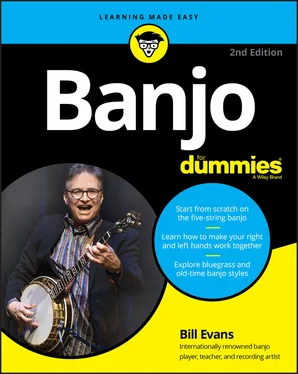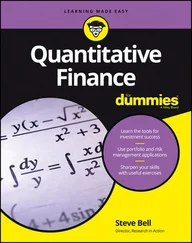G / G♯ or A♭ / A / A♯ or B♭ / B / C / C♯ or D♭ / D / D♯ or E♭ / E / F / F♯ or G♭ / G
Here are a few tidbits of info that may help you better understand this series of notes and how they relate to tuning your banjo:
Equivalent notes: You may notice that some notes in the preceding series have an or between them. Without getting too boring, just remember that a G♯ is the same pitch as an A♭, an A♯ is the same as a B♭, and so on. These equivalent notes are found at the same fret on your fingerboard.
Pitch: As you move to the right in the order of notes, you're naming higher-pitched notes; as you move to the left, the notes are lower pitched.
Half versus whole steps: If you move one note in either direction (for instance, going from a C♯ or D♭ note to a D note), you move a half step. If you move two notes in either direction (for instance, going from an F to a G or from a C to a D), you move a whole step. A half-step movement corresponds to a change of one fret up or down on your banjo fingerboard, and a whole step equals a movement of two frets from one note to the next. For example, if you're playing an open string and you want to move up a half step, you fret the 1st fret of that same string. If you want to move up a whole step from an open string, you fret the 2nd fret.
To use an electronic tuner, you turn the tuning pegs until the readout matches the note that string should match. For example, if you're trying to tune your 3rd string to a G and the tuner gives you an F♯ reading, you know from the preceding order of notes that your 3rd string is far enough below a G pitch that the tuner hears the note as an F♯ — the pitch that's one half step below G.
To get your 3rd string in tune, continue striking the 3rd string with the right hand and slowly turn the tuning peg to raise the string's pitch. At some point, the tuner's readout should change from an F♯ to a G note, but at this point the tuner tells you that your 3rd string is a flat G note instead of a sharp F♯. Continue raising the pitch of the string until the tuner indicates that the string is exactly in tune to a G note. You use the same process for each of the strings, raising or lowering their pitches until the tuner indicates that you've reached the desired note.
 Don't strike the strings too hard when using an electronic tuner. A light touch is best for the tuner to give the most reliable reading. Also, the meter on some tuners shifts slightly to the left or right as it responds to ever-so-slight changes in pitch that occur as a string continues to vibrate. If this happens to you, tune the string to the pitch that the indicator “sits on” for the majority of the time that the tuner is registering its pitch. This approximation gets you close enough to do a touch-up on that string by using relative-tuning techniques (see the previous section on this topic for instructions).
Don't strike the strings too hard when using an electronic tuner. A light touch is best for the tuner to give the most reliable reading. Also, the meter on some tuners shifts slightly to the left or right as it responds to ever-so-slight changes in pitch that occur as a string continues to vibrate. If this happens to you, tune the string to the pitch that the indicator “sits on” for the majority of the time that the tuner is registering its pitch. This approximation gets you close enough to do a touch-up on that string by using relative-tuning techniques (see the previous section on this topic for instructions).
Tuning with an electronic tuner at a jam session
When musicians come together to make music, they first take some time to make sure that their instruments are in tune with one another before they start to play. Just before a jam session begins, you may see musicians off in different corners or with their backs turned momentarily from the main group, as they get in tune by using electronic clip-on tuners (see the preceding section for the how-to). In this case, the participants use the reference notes provided by their tuners to get as closely in tune with each other as they can. (If the participants have their backs turned because they're talking to their agents, you might have found an advanced jam session!)
 Don't hesitate to borrow another musician's tuner whenever you need one in a group session. Believe me — everyone wants you to be in tune just as much as you do!
Don't hesitate to borrow another musician's tuner whenever you need one in a group session. Believe me — everyone wants you to be in tune just as much as you do!
If your jam session is taking place outside, as often happens at a music festival, chances are good that all the instruments will gradually drift out of absolute tuning in reaction to the sun, the humidity, and warm temperatures. If you're joining a jam session that's already in progress, the musicians may be in tune with each other but not with your tuner. In these situations, get a reference pitch from another instrumentalist and tune your banjo to that instrument using the guidelines in the next section.
Using another instrument as a reference
If you don't have an electronic tuner or you want to be in tune with others in a jam session, you can use pitches from other instruments to get your banjo where it needs to be. In general, ask another musician to play a certain note on her instrument. Then, try to get your string to match that pitch by turning the tuning pegs. After tuning each open string to the corresponding note, you can then double-check your tuning by using relative tuning techniques (see the section on this topic earlier in this chapter).
Here's how you can use various instruments to tune your banjo:
Guitar or dobro: The 4th (D), 3rd (G), and 2nd (B) strings of the guitar are tuned to the same pitches as the corresponding strings in G tuning on the banjo (see the section on G tuning earlier in this chapter for more info). The dobro's top four strings are tuned to the same pitches as the top four strings on your banjo, so if someone in your jam session is playing one of these instruments, ask to use his pitches as reference points for you to tune your banjo — as long as that person is also in tune, that is! I usually try to tune my 3rd-string G first, and then I move down in pitch to tune the 4th string and up to tune the 2nd, 1st, and 5th strings. When I have a break in between songs, I ask the guitar or dobro player to play a 3rd string open, or the fretted equivalent if she has a capo on, so I can make sure my banjo is in tune with the other instruments. If I'm out of tune, I make adjustments on each string until my strings’ pitches match the pitches on the guitar or dobro.
Piano: If you have a piano or an electronic keyboard around the house, that's another great source for getting reference notes to tune your banjo. Tune each banjo string to the corresponding piano note (see Figure 2-3).
Fiddle or mandolin: If you're playing music with just a fiddler or a mandolin player, you can still get in tune with her by asking for her G note. A fiddle is tuned to the same pitches as a mandolin. The open G note on these instruments is the same as your 5th-string G pitch but is an octave higher in pitch than your 3rd-string G.However, you can still use this note to tune your G string, and then you can tune your remaining strings using relative tuning techniques (see the section “ Relative Tuning: Tuning the Banjo to Itself” earlier in this chapter for more help). Or, you can ask for the other pitches you need to get the other strings in tune.

Illustration by Wiley, Composition Services Graphics
FIGURE 2-3:Piano notes and their corresponding strings on the banjo.
 The tone of the other instrumentalist's notes is going to be different than the notes on the banjo, but remember that you're comparing the pitch of each note, not the tone. When in doubt about your own tuning, don't hesitate to ask another musician for help.
The tone of the other instrumentalist's notes is going to be different than the notes on the banjo, but remember that you're comparing the pitch of each note, not the tone. When in doubt about your own tuning, don't hesitate to ask another musician for help.
Читать дальше

 Don't strike the strings too hard when using an electronic tuner. A light touch is best for the tuner to give the most reliable reading. Also, the meter on some tuners shifts slightly to the left or right as it responds to ever-so-slight changes in pitch that occur as a string continues to vibrate. If this happens to you, tune the string to the pitch that the indicator “sits on” for the majority of the time that the tuner is registering its pitch. This approximation gets you close enough to do a touch-up on that string by using relative-tuning techniques (see the previous section on this topic for instructions).
Don't strike the strings too hard when using an electronic tuner. A light touch is best for the tuner to give the most reliable reading. Also, the meter on some tuners shifts slightly to the left or right as it responds to ever-so-slight changes in pitch that occur as a string continues to vibrate. If this happens to you, tune the string to the pitch that the indicator “sits on” for the majority of the time that the tuner is registering its pitch. This approximation gets you close enough to do a touch-up on that string by using relative-tuning techniques (see the previous section on this topic for instructions). Don't hesitate to borrow another musician's tuner whenever you need one in a group session. Believe me — everyone wants you to be in tune just as much as you do!
Don't hesitate to borrow another musician's tuner whenever you need one in a group session. Believe me — everyone wants you to be in tune just as much as you do!
 The tone of the other instrumentalist's notes is going to be different than the notes on the banjo, but remember that you're comparing the pitch of each note, not the tone. When in doubt about your own tuning, don't hesitate to ask another musician for help.
The tone of the other instrumentalist's notes is going to be different than the notes on the banjo, but remember that you're comparing the pitch of each note, not the tone. When in doubt about your own tuning, don't hesitate to ask another musician for help.










